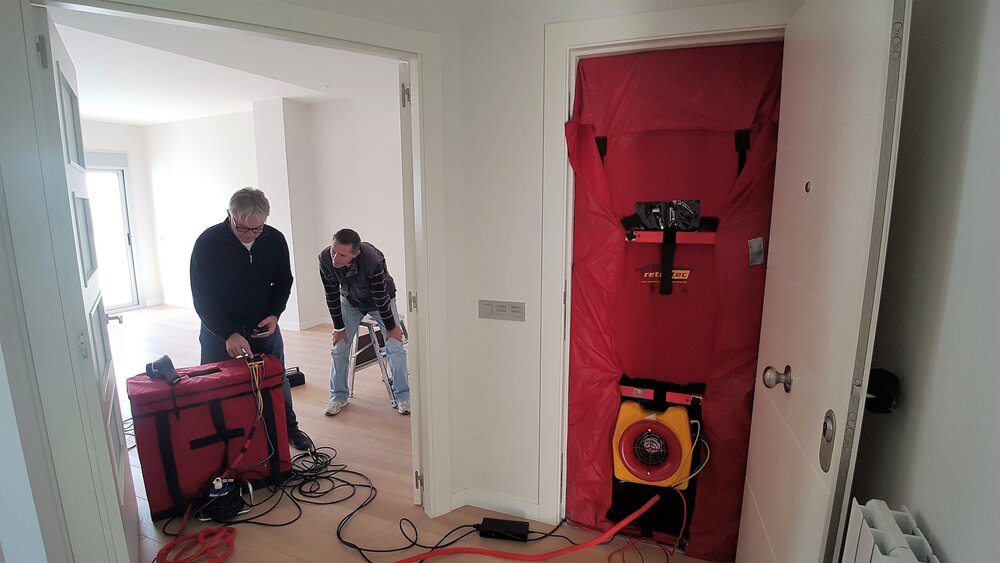Airtightness is a very important factor in achieving a building with low energy consumption. The Blower Door test allows measuring air infiltrations in buildings and detecting air leaks in the envelope.
What does the Blower Door test consist of?
The Blower Door test is the most effective method to detect air infiltrations in buildings and evaluate the permeability of their envelope. Its incorporation into the construction process and energy retrofitting allows for the correction of design or construction errors and ensures the achievement of initial objectives regarding comfort temperature and energy consumption.
Buildings require controlled ventilation to maintain air quality, but infiltrations through the envelope are those unwanted air exchanges. These can arise due to the porosity of construction materials, poorly finished joints, or unidentified openings. Additionally, infiltrations can cause other problems such as noise, entry of dirt, odours, fumes from outside, and other contaminants.
In order to create really efficient buildings and not to lose energy, it is essential to control unwanted leakage losses. The thermal envelope, formed by the elements that enclose the conditioned spaces: facade, roof, envelopes, floor, and unconditioned spaces, is responsible for maintaining the desired temperature inside, so leak-tightness in its design and execution is a key factor.
The test is conducted in accordance with EN13829 and must be performed by an independent expert who is not involved in the certification process of the building and who chooses the best time and conditions for carrying out the test.
With the Blower Door test, we are able to measure the sealing capacity and the airtightness of the building, calculate the hourly renewals and analyse the leakage rate.
How is a Blower Door test conducted?
The test consists of placing a tarp with an adjustable metal frame that covers the entire main entrance, leaving only a fan passage. This fan is responsible for extracting air from the interior until reaching the optimal pressure level to obtain the results. The installation is connected to a computerized system that will allow us to analyse the data obtained.
For new buildings, it is recommended to carry out various tests during the construction process. In this way, we can detect possible defects in the envelope and solve them more easily than with the building completed.
These are the steps to follow to perform the Blower Door test:
- Introduction of building data into the testing system software: The data for surface area, perimeter of the envelope, height, degree of wind exposure, window surface area, smoke extraction systems, etc. are entered. Everything that can influence the airtightness of the building and that needs to be taken into account.
- Preparation of the space to be tested: Proceed to close exterior doors and windows, seal all air entries such as ventilation grilles, hoods, chimneys, etc. And place the system at the main door. In its beginnings, the test started being done through a window, but it has now been proven to be much more effective at the front door.
- Overpressure test : Air is brought in from the outside using the fan until a pressure difference of 50 pascals between the inside and the outside is achieved. Under these circumstances, the tendency of the air to leave the volume of the building through any opening or semi-permeable surface of the envelope can be observed. If a thermal camera is available, on a cold day you will be able to see the hot air exiting the building.
- Depression test: The operation of the fan is reversed this time, extracting air from inside to outside the building. This way, the entrances can be seen from the outside. The test can be complemented with a smoke machine that allows for easy detection of infiltrations.
- Obtaining results: The computer system connected to the fan measures the relationship between the pressure level and the fan's rotation speed. Such speed is proportional to the volume of air moved by the fan.
From the volume of air flowing through the ventilation fan and the dimensions of the building to be tested, the various test parameters can be derived:
- The equivalent dimension of the openings of the envelope in m2
- The renewal rate per hour n50
- The infiltration rate as a function of the envelope surface area q50
- Estimation of the energy consumption produced by leaks
Applications and use
The Blower Door test was invented in 1975 in Sweden, and is now widely used to ensure the quality of envelope finishes.
It presents important advantages compared to others: speed of execution, no building work required, and its complementarity with other studies such as thermographies. Thus, its results improve energy efficiency very significantly in relation to the effort to conduct the test.
In Spain, the demand for airtightness is on the rise, although there are no airtightness regulations that make it compulsory. The Technical Building Code (CTE) does not consider a maximum level of renewals per hour, although some sustainability standards such as Passivhaus do, where 0.6 renewals cannot be exceeded.
Some energy certification programs allow the introduction of test results if conducted, although it is not mandatory, thus significantly improving the score obtained.
Its cost
At the cost level, according to the Blower Door Test, conducting the test in a house of up to 250 m2 would cost approximately €300 and 2.5 hours of work. Doing it with the highly recommended leak detection supplement, in the same dwelling, would increase the cost up to €380 and the time up to 4 hours, still being quick and economical.
The BREEAM certification recommends its implementation at different stages of the construction process in order to solve possible errors on the fly, and carrying it out means the addition of a point if an hourly renewal rate of less than 0.2 m3/h/m2 is achieved.
In LEED projects, it is one of the tests usually required on the envelope within the commissioning section, which awards a total of 2 points.
Zero Consulting has been committed to Blower Door tests as an evaluation method since 2012. We have conducted this type of study in numerous projects for passive houses and energy rehabilitations, but also in larger constructions such as logistics platforms, business parks, or large commercial areas.


